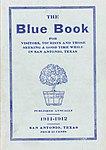Prospect Hill Missionary Baptist Church
20th-century Baptist churches in the United StatesBaptist churches in TexasBeaux-Arts architecture in TexasChurches completed in 1911Churches in San Antonio ... and 4 more
Churches on the National Register of Historic Places in TexasNational Register of Historic Places in San AntonioTexas Registered Historic Place stubsTexas church stubs

Prospect Hill Missionary Baptist Church (Prospect Hill Baptist Church) is a historic Baptist church building at 1601 Buena Vista in San Antonio, Texas. The Beaux Arts style building was constructed in 1911 and added to the National Register of Historic Places in 1986.
Excerpt from the Wikipedia article Prospect Hill Missionary Baptist Church (License: CC BY-SA 3.0, Authors, Images).Prospect Hill Missionary Baptist Church
West Commerce Street, San Antonio
Geographical coordinates (GPS) Address Nearby Places Show on map
Geographical coordinates (GPS)
| Latitude | Longitude |
|---|---|
| N 29.426111111111 ° | E -98.505277777778 ° |
Address
West Commerce Street 1000
78207 San Antonio
Texas, United States
Open on Google Maps








